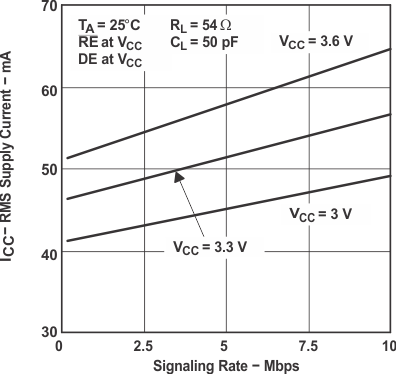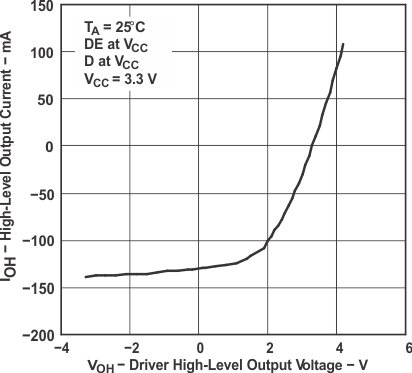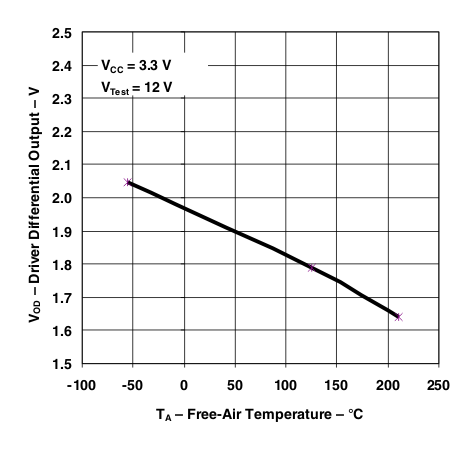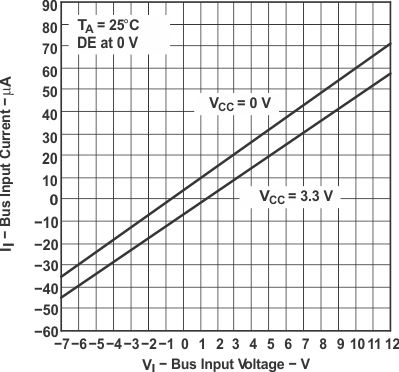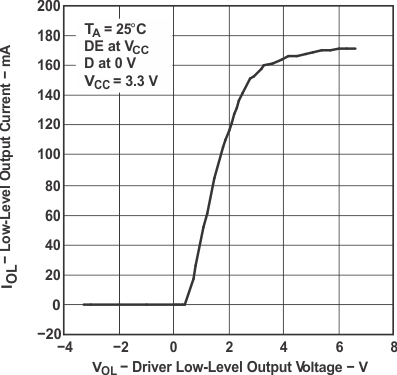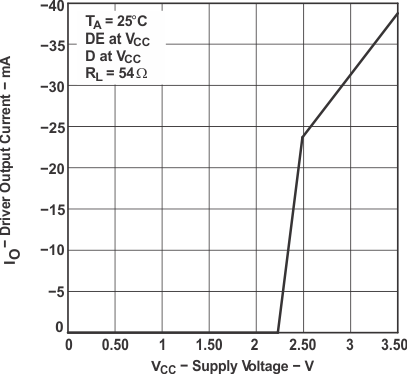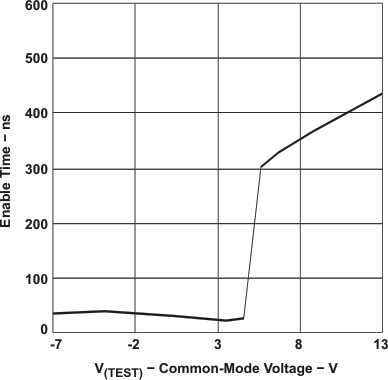SLLS934F November 2008 – November 2015 SN65HVD11-HT
PRODUCTION DATA.
- 1 Features
- 2 Applications
- 3 Description
- 4 Revision History
- 5 Pin Configuration and Functions
- 6 Specifications
- 7 Parameter Measurement Information
- 8 Detailed Description
- 9 Application and Implementation
- 10Power Supply Recommendations
- 11Layout
- 12Device and Documentation Support
- 13Mechanical, Packaging, and Orderable Information
Package Options
Mechanical Data (Package|Pins)
Thermal pad, mechanical data (Package|Pins)
Orderable Information
6 Specifications
6.1 Absolute Maximum Ratings
over operating free-air temperature range (unless otherwise noted)(1)| MIN | MAX | UNIT | ||||
|---|---|---|---|---|---|---|
| VCC | Supply voltage | –0.3 | 6 | V | ||
| Voltage at A or B | –9 | 14 | V | |||
| Input voltage at D, DE, R, or RE | –0.5 | VCC + 0.5 | V | |||
| Voltage input, transient pulse, A and B, through 100 Ω (see Figure 20) | –50 | 50 | V | |||
| IO | Receiver output current | –11 | 11 | mA | ||
| Continuous total power dissipation | See Thermal Information | |||||
(1) All voltage values, except differential I/O bus voltages, are with respect to network ground terminal.
6.2 ESD Ratings
| VALUE | UNIT | ||||
|---|---|---|---|---|---|
| V(ESD) | Electrostatic discharge | Human-body model (HBM), per ANSI/ESDA/JEDEC JS-001(1) | A, B, and GND | ±16000 | V |
| All pins | ±4000 | ||||
| Charged-device model (CDM), per JEDEC specification JESD22-C101(2) | ±1000 | ||||
(1) JEDEC document JEP155 states that 500-V HBM allows safe manufacturing with a standard ESD control process.
(2) JEDEC document JEP157 states that 250-V CDM allows safe manufacturing with a standard ESD control process.
6.3 Recommended Operating Conditions
| MIN | NOM | MAX | UNIT | |||
|---|---|---|---|---|---|---|
| VCC | Supply voltage | 3 | 3.6 | V | ||
| VI or VIC | Voltage at any bus terminal (separately or common-mode) | –7(1) | 12 | V | ||
| VIH | High-level input voltage | D, DE, RE | 2 | VCC | V | |
| VIL | Low-level input voltage | D, DE, RE | 0 | 0.8 | V | |
| VID | Differential input voltage | Figure 16 | –12 | 12 | V | |
| IOH | High-level output current | Driver | –60 | mA | ||
| Receiver | –8 | |||||
| IOL | Low-level output current | Driver | 60 | mA | ||
| Receiver | 8 | |||||
| RL | Differential load resistance | 54 | 60 | Ω | ||
| CL | Differential load capacitance | 50 | pF | |||
| Signaling rate | 10 | Mbps | ||||
| TJ(2) | Operating junction temperature | TA = –55°C to 125°C | 129 | °C | ||
| TA = 175°C | 179 | |||||
| TA = 210°C | 214 | |||||
(1) The algebraic convention, in which the least-positive (most-negative) limit is designated as minimum, is used in this data sheet.
(2) See Thermal Information table for information regarding this specification.
6.4 Thermal Information
| THERMAL METRIC(1) | SN65HVD11-HT | UNIT | ||||
|---|---|---|---|---|---|---|
| D (SOIC) | JD (CDIP SB) | HKJ (CFP) | HKQ (CFP) | |||
| 8 PINS | 8 PINS | 8 PINS | 8 PINS | |||
| RθJA | Junction-to-ambient thermal resistance | 101.5 | 73.9 | N/A | 170 | °C/W |
| RθJC(top) | Junction-to-case (top) thermal resistance | 53.6 | N/A | N/A | 6.2 | °C/W |
| RθJB | Junction-to-board thermal resistance | 45.1 | 39.8 | N/A | 195 | °C/W |
| ψJT | Junction-to-top characterization parameter | 4.8 | 6.9 | N/A | 3.8 | °C/W |
| ψJB | Junction-to-board characterization parameter | 41.8 | 49.2 | N/A | 146.8 | °C/W |
| RθJC(bot) | Junction-to-case (bottom) thermal resistance | N/A | 9.1 | 6.2 | N/A | °C/W |
(1) For more information about traditional and new thermal metrics, see the Semiconductor and IC Package Thermal Metrics application report, SPRA953.
6.5 Driver Electrical Characteristics
over recommended operating conditions (unless otherwise noted)| PARAMETER | TEST CONDITIONS | MIN | TYP | MAX | UNIT | ||||
|---|---|---|---|---|---|---|---|---|---|
| VIK | Input clamp voltage | II = –18 mA | –1.5 | V | |||||
| |VOD| | Differential output voltage | IO = 0 | 2 | VCC | V | ||||
| RL = 54 Ω, See Figure 10 | 1 | ||||||||
| Vtest = –7 V to 12 V, See Figure 11 |
1 | ||||||||
| Δ|VOD| | Change in magnitude of differential output voltage | Vtest = –7 V to 12 V, See Figure 10 and Figure 11 |
–0.2 | 0.2 | V | ||||
| VOC(PP) | Peak-to-peak common mode output voltage | See Figure 12 | 400 | mV | |||||
| VOC(SS) | Steady-state common mode output voltage | See Figure 12 | 1.4 | 2.5 | V | ||||
| ΔVOC(SS) | Change in steady-state common mode output voltage | See Figure 12 | –0.06 | 0.06 | V | ||||
| IOZ | High-impedance output current | See receiver input currents | |||||||
| II | Input current | D | TA = –55°C to 125°C | –100 | 0 | μA | |||
| TA = 175°C(1) | –100 | 3 | |||||||
| TA = 210°C(2) | –100 | 3 | |||||||
| DE | 0 | 100 | |||||||
| IOS | Short circuit output current | –7 V ≤ VO ≤ 12 V | –250 | 250 | mA | ||||
| C(OD) | Differential output capacitance | VOD = 0.4 sin (4E6πt) + 0.5 V, DE = 0 V |
18 | pF | |||||
| ICC | Supply current | RE = VCC, D and DE = VCC, No load |
Receiver disabled and driver enabled | TA = –55°C to 125°C | 11 | 15.5 | mA | ||
| TA = 175°C(1) | 11.5 | 17.5 | |||||||
| TA = 210°C(2) | 14 | 18 | |||||||
| RE = VCC, D = VCC, DE = 0 V, No load |
Receiver disabled and driver disabled (standby) | TA = –55°C to 125°C | 2.5 | 20 | μA | ||||
| TA = 175°C(1) | 20 | 150 | |||||||
| TA = 210°C(2) | 175 | 450 | |||||||
| RE = 0 V, D and DE = VCC, No load |
Receiver enabled and driver enabled | TA = –55°C to 125°C | 11 | 15.5 | mA | ||||
| TA = 175°C(1) | 11 | 17.5 | |||||||
| TA = 210°C(2) | 11 | 18 | |||||||
(1) Minimum and maximum parameters are characterized for operation at TA = 175°C but may not be production tested at that temperature. Production test limits with statistical guardbands are used to ensure high temperature performance.
(2) Minimum and maximum parameters are characterized for operation at TA = 210°C but may not be production tested at that temperature. Production test limits with statistical guardbands are used to ensure high temperature performance.
6.6 Receiver Electrical Characteristics
over recommended operating conditions (unless otherwise noted)| PARAMETER | TEST CONDITIONS | MIN | TYP | MAX | UNIT | |||
|---|---|---|---|---|---|---|---|---|
| VIT+ | Positive-going input threshold voltage | IO = –8 mA | –0.01 | V | ||||
| VIT– | Negative-going input threshold voltage | IO = 8 mA | –0.2 | V | ||||
| Vhys | Hysteresis voltage (VIT+ –VIT–) |
TA = –55°C to 125°C | 35 | mV | ||||
| TA = 175°C(1) | 41 | |||||||
| TA = 210°C(2) | 41 | |||||||
| VIK | Enable-input clamp voltage | II = –18 mA | –1.5 | V | ||||
| VOH | High-level output voltage | VID = 200 mV, IOH = –8 mA, See Figure 16 |
2.4 | V | ||||
| VOL | Low-level output voltage | VID = –200 mV, IOL = 8 mA, See Figure 16 |
0.4 | V | ||||
| IOZ | High-impedance state output current | VO = 0 or VCC,RE = VCC | –1 | 1 | μA | |||
| II | Bus input current | VA or VB = 12 V | Other input at 0 V |
TA = –55°C to 125°C | 0.075 | 0.11 | mA | |
| TA = 175°C(1) | 0.1 | 0.15 | ||||||
| TA = 210°C(2) | 0.1 | 0.15 | ||||||
| VA or VB = 12 V, VCC = 0 V |
TA = –55°C to 125°C | 0.085 | 0.13 | |||||
| TA = 175°C(1) | 0.12 | 0.16 | ||||||
| TA = 210°C(2) | 0.12 | 0.16 | ||||||
| VA or VB = –7 V | TA = –55°C to 125°C | –0.1 | –0.05 | |||||
| TA = 175°C(1) | –0.3 | –0.15 | ||||||
| TA = 210°C(2) | –0.3 | –0.15 | ||||||
| VA or VB = –7 V, VCC = 0 V |
TA = –55°C to 125°C | –0.1 | –0.05 | |||||
| TA = 175°C(1) | –0.3 | –0.15 | ||||||
| TA = 210°C(2) | –0.3 | –0.15 | ||||||
| IIH | High-level input current, RE | VIH = 2 V | TA = –55°C to 125°C | –30 | 0 | μA | ||
| TA = 175°C(1) | –30 | 3 | ||||||
| TA = 210°C(2) | –30 | 3 | ||||||
| IIL | Low-level input current, RE | VIL = 0.8 V | –30 | 0 | μA | |||
| CID | Differential input capacitance | VID = 0.4 sin (4E6πt) + 0.5 V, DE at 0 V |
TA = –55°C to 125°C | 15 | pF | |||
| TA = 175°C(1) | 18 | |||||||
| TA = 210°C(2) | 18 | |||||||
| ICC | Supply current | RE = 0 V, D and DE = 0 V, No load |
Receiver enabled and driver disabled | TA = –55°C to 125°C | 5 | 8 | mA | |
| TA = 175°C(1) | 7.5 | 8.5 | ||||||
| TA = 210°C(2) | 7.5 | 10 | ||||||
| RE = VCC, D = VCC, DE = 0 V, No load |
Receiver disabled and driver disabled (standby) | TA = –55°C to 125°C | 2.5 | 20 | μA | |||
| TA = 175°C(1) | 12.5 | 200 | ||||||
| TA = 210°C(2) | 175 | 450 | ||||||
| RE = 0 V, D and DE = VCC, No load |
Receiver enabled and driver enabled | TA = –55°C to 125°C | 11 | 15.5 | mA | |||
| TA = 175°C(1) | 11.5 | 17.5 | ||||||
| TA = 210°C(2) | 14 | 18 | ||||||
(1) Minimum and maximum parameters are characterized for operation at TA = 175°C but may not be production tested at that temperature. Production test limits with statistical guardbands are used to ensure high temperature performance.
(2) Minimum and maximum parameters are characterized for operation at TA = 210°C but may not be production tested at that temperature. Production test limits with statistical guardbands are used to ensure high temperature performance.
6.7 Driver Switching Characteristics
over recommended operating conditions (unless otherwise noted)| PARAMETER | TEST CONDITIONS | MIN | TYP | MAX | UNIT | |||
|---|---|---|---|---|---|---|---|---|
| tPLH | Propagation delay time, low-to-high-level output | RL = 54 Ω, CL = 50 pF, See Figure 13 |
18 | 25 | 40 | ns | ||
| tPHL | Propagation delay time, high-to-low-level output | 18 | 25 | 40 | ns | |||
| tr | Differential output signal rise time | TA = –55°C to 125°C | 10 | 21 | 30 | ns | ||
| TA = 175°C(1) | 10 | 22 | 30 | |||||
| TA = 210°C(2) | 10 | 22 | 30 | |||||
| tf | Differential output signal fall time | TA = –55°C to 125°C | 10 | 21 | 30 | ns | ||
| TA = 175°C(1) | 10 | 22 | 30 | |||||
| TA = 210°C(2) | 10 | 22 | 30 | |||||
| tsk(p) | Pulse skew (|tPHL – tPLH|) | 2.5 | ns | |||||
| tsk(pp)(3) | Part-to-part skew (tPHL or tPLH) | 11 | ns | |||||
| tPZH | Propagation delay time, high-impedance to high-level output | RL = 110 Ω, RE = 0 V, See Figure 14 |
55 | ns | ||||
| tPHZ | Propagation delay time, high-level to high-impedance output | 55 | ns | |||||
| tPZL | Propagation delay time, high-impedance to low-level output | RL = 110 Ω, RE = 0 V, See Figure 15 |
55 | ns | ||||
| tPLZ | Propagation delay time, low-level to high-impedance output | 75 | ns | |||||
| tPZH | Propagation delay time, standby to high-level output | RL = 110 Ω, RE = 3 V, See Figure 14 |
6 | μs | ||||
| tPZL | Propagation delay time, standby to low-level output | RL = 110 Ω, RE = 3 V, See Figure 15 |
6 | μs | ||||
(1) Minimum and maximum parameters are characterized for operation at TA = 175°C but may not be production tested at that temperature. Production test limits with statistical guardbands are used to ensure high temperature performance.
(2) Minimum and maximum parameters are characterized for operation at TA = 210°C but may not be production tested at that temperature. Production test limits with statistical guardbands are used to ensure high temperature performance.
(3) tsk(pp) is the magnitude of the difference in propagation delay times between any specified terminals of two devices when both devices operate with the same supply voltages, at the same temperature, and have identical packages and test circuits.
6.8 Receiver Switching Characteristics
over recommended operating conditions (unless otherwise noted)| PARAMETER | TEST CONDITIONS | MIN | TYP | MAX | UNIT | |||
|---|---|---|---|---|---|---|---|---|
| tPLH | Propagation delay time, low-to-high-level output | VID = –1.5 V to 1.5 V, CL = 15 pF, See Figure 17 |
30 | 55 | 70 | ns | ||
| tPHL | Propagation delay time, high-to-low-level output | 30 | 55 | 70 | ns | |||
| tsk(p) | Pulse skew (|tPHL – tPLH|) | 4 | ns | |||||
| tsk(pp)(3) | Part-to-part skew | 15 | ns | |||||
| tr | Output signal rise time | CL = 15 pF, See Figure 17 |
TA = –55°C to 125°C | 1 | 3 | 5 | ns | |
| TA = 175°C(1) | 1 | 4 | 5 | |||||
| TA = 210°C(2) | 1 | 4 | 5 | |||||
| tf | Output signal fall time | TA = –55°C to 125°C | 1 | 3 | 5 | ns | ||
| TA = 175°C(1) | 1 | 4 | 5 | |||||
| TA = 210°C(2) | 1 | 4 | 5 | |||||
| tPZH(2) | Output enable time to high level | CL = 15 pF, DE = 3 V, See Figure 18 |
15 | ns | ||||
| tPZL(2) | Output enable time to low level | 15 | ns | |||||
| tPHZ | Output disable time from high level | 20 | ns | |||||
| tPLZ | Output disable time from low level | 15 | ns | |||||
| tPZH(3) | Propagation delay time, standby-to-high-level output | CL = 15 pF, DE = 0, See Figure 19 |
6 | μs | ||||
| tPZL(3) | Propagation delay time, standby-to-low-level output | 6 | μs | |||||
(1) Minimum and maximum parameters are characterized for operation at TA = 175°C but may not be production tested at that temperature. Production test limits with statistical guardbands are used to ensure high temperature performance.
(2) Minimum and maximum parameters are characterized for operation at TA = 210°C but may not be production tested at that temperature. Production test limits with statistical guardbands are used to ensure high temperature performance.
(3) tsk(pp) is the magnitude of the difference in propagation delay times between any specified terminals of two devices when both devices operate with the same supply voltages, at the same temperature, and have identical packages and test circuits.
xxx
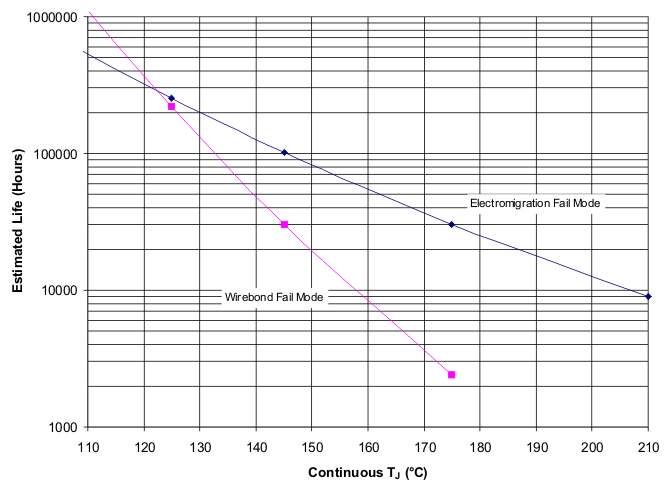
1. See data sheet for absolute maximum and minimum recommended operating conditions.
2. Silicon operating life design goal is 10 years at 105°C junction temperature (does not include package interconnect life).
3. The predicted operating lifetime vs. junction temperature is based on reliability modeling using electromigration as the dominant failure mechanism affecting device wearout for the specific device process and design characteristics.
4. Wirebond fail mode applicable for D package only.
5. Wirebond life approaches 0 hours < 200°C which is only true of the HD device.
Figure 1. SN65HVD11SJD/SKGDA/SHKJ/SHKQ/HDOperating Life Derating Chart
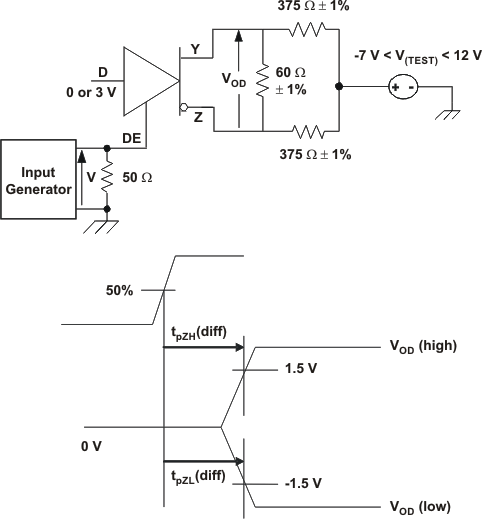
NOTE:
The time tpZL(x) is the measure from DE to VOD(x). VOD is valid when it is greater than 1.5 V.6.9 Typical Characteristics
